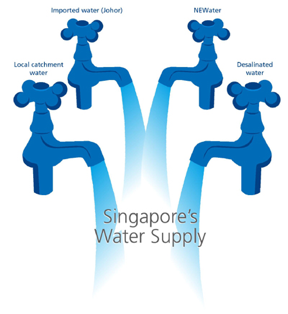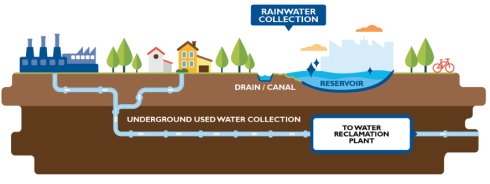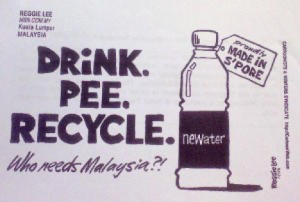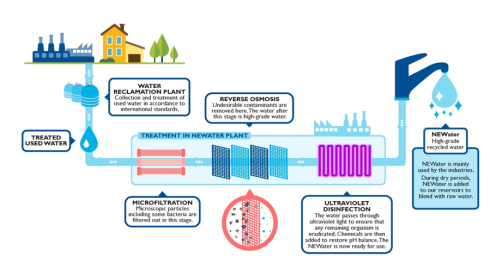With a land area of only 719.2km, Singapore is one of the small countries in the world, and one of only three city-states in existence. A small land mass in itself does not provide any issues for comfortable existence, it is when the population begins to outgrow the land available that problems arise. For the country of Singapore, this issue was without a doubt one that applied to their situation, with a rapidly growing population and setting themselves up as a hub for the Asian-pacific region, the Singaporean government had many issues to face not only for the extreme conditions or events, but for everyday life, and the focus of this post will be water. What does a country do when they begin to run out of land but the population continues to grow? Where do they source their water to prevent the introduction of unsanitary drinking water?
 For Singapore the answer was found down four different avenues: the first and most interesting is the harvesting of Rain water. The development of a water network connecting all parts of the country with all of the 17 reservoirs allows for a large stockpile of drinkable water though as well of run off outside of urban areas, the Singaporean society harvest the urban rainwater. The majority of rain that falls on the street, houses, buildings and industries is collected and sent to treatment plants. Upon discovering this it was easy to connect the dots and understand why there are such strict laws for hygiene and cleanliness in the city (Spitting being prohibited etc.) as street run off is filtered and cleaned and reused as drinking water. This means that any pollutants on the street and in the drain systems are in contact with water than will be consumed by the population and hence there are such strict regimes in the day to day life of the city. For people who live in less densely populated areas (Singapore as 7,797 people per square kilometer) this issue of running out of water would be unheard of as there is enough space and reservoirs to provide the population with drinking water. It is interesting to consider how such a well-developed country is so reliant on reusing water because if they didn’t they would simply run out purely due to lack of space and catchment area.
For Singapore the answer was found down four different avenues: the first and most interesting is the harvesting of Rain water. The development of a water network connecting all parts of the country with all of the 17 reservoirs allows for a large stockpile of drinkable water though as well of run off outside of urban areas, the Singaporean society harvest the urban rainwater. The majority of rain that falls on the street, houses, buildings and industries is collected and sent to treatment plants. Upon discovering this it was easy to connect the dots and understand why there are such strict laws for hygiene and cleanliness in the city (Spitting being prohibited etc.) as street run off is filtered and cleaned and reused as drinking water. This means that any pollutants on the street and in the drain systems are in contact with water than will be consumed by the population and hence there are such strict regimes in the day to day life of the city. For people who live in less densely populated areas (Singapore as 7,797 people per square kilometer) this issue of running out of water would be unheard of as there is enough space and reservoirs to provide the population with drinking water. It is interesting to consider how such a well-developed country is so reliant on reusing water because if they didn’t they would simply run out purely due to lack of space and catchment area.
The other avenues from which Singapore source their water include importing water from Malaysia, desalination and the other, more interesting source, is a process called NEWater. This process involves completely recycling and cleansing the water from the Singaporean community. The NEWater is predominantly used for industrial purposes and the cooling of air-conditioning units throughout the country, though at this stage there are no direct NEWater lines between the plants and residential locations, only industrial and  commercial buildings. NEWater, despite being cleaner and at a purer standard than the current drinking water, is only used for consumption in dry weather periods, and is introduced via the existing reservoirs, so the NEWater is added to the reservoirs to bond with the existing drinking water and only then is it sent to homes and other water sources around the country. It is interesting to contemplate that the only reason for this non-direct drinking of the NEWater is just personal preference of the majority of society, it has been proven that the NEWater is cleaner and purer though the population would presumably still not be content with drinking recycled sewage water. Though considering this, at the current state NEWater can create and supply 40% of all used water in Singapore and by 2060 this will increase to 55%, so perhaps direct drinking connections will be implemented in the future?
commercial buildings. NEWater, despite being cleaner and at a purer standard than the current drinking water, is only used for consumption in dry weather periods, and is introduced via the existing reservoirs, so the NEWater is added to the reservoirs to bond with the existing drinking water and only then is it sent to homes and other water sources around the country. It is interesting to contemplate that the only reason for this non-direct drinking of the NEWater is just personal preference of the majority of society, it has been proven that the NEWater is cleaner and purer though the population would presumably still not be content with drinking recycled sewage water. Though considering this, at the current state NEWater can create and supply 40% of all used water in Singapore and by 2060 this will increase to 55%, so perhaps direct drinking connections will be implemented in the future?
These water sources are a clear case of Singapore being faced with a severe issue, not enough clean usable water for the population growth, and it is quite interesting to see the varying solutions that have been implemented, though more intriguing that multiple solutions where introduced, not just a single source. It seems they are backing themselves up and ensuring a source in case of failure, a very smart decision and one that appears to be suiting the society incredibly well.
References
Four National Taps of Singapore 2017, viewed 21 January 2017, <http://www.water-treatment.com.cn/plants/list/images/Singapore_national_taps.jpg>.
Lee, R. 2017, Drink. Pee. Recycle., viewed 21 January 2017, <http://followgreenliving.com/wp-content/uploads/2014/04/malysia-300×202.jpg>.
NEWater Technology 2017, 1st edn, Singapore, pp. 1-1. viewed 21 January 2017, <https://www.pub.gov.sg/Documents/NEWater%20Technology.pdf>.
PUB, 2017, NEWater Quality, viewed 21 January 2017, <https://www.pub.gov.sg/PublishingImages/NEWaterDemographics.jpg>.
PUB, 2017, Singapore’s experience in Stormwater Harvesting, The Lower Seletar/Bedok Water Scheme, Singapore. viewed 21 January 2017, <http://www.jwrc-net.or.jp/aswin/projects-activities/rd_files/jp-sg_symposium/2012_07_07.pdf>.
PUB, Singapore’s National Water Agency 2017, PUB, Singapore’s National Water Agency. viewed 21 January 2017, <https://www.pub.gov.sg/watersupply/fournationaltaps/localcatchmentwater>.
PUB, Singapore’s National Water Agency 2017, PUB, Singapore’s National Water Agency. viewed 21 January 2017, <https://www.pub.gov.sg/watersupply/fournationaltaps/newater>.
sgPUB, 2017, Enhancing Singapore’s Drainage Systems – Ongoing Improvement Projects, viewed 21 January 2017, <http://Enhancing Singapore’s Drainage Systems – Ongoing Improvement Projects>.
sgPUB, 2017, The Singapore Water Story, viewed 21 January 2017, <https://www.youtube.com/watch?v=5BGUT7BjPl0>.
Singapore Department of Statistics, 2017, Population & Land Area, Singapore, p. http://www.singstat.gov.sg/statistics/latest-data#16.
Singapore’s National Water Agency, 2017, NEWater, viewed 21 January 2017, <https://www.pub.gov.sg/PublishingImages/NEWaterDemographics.jpg>.
The Rainwater Harvesting System at Mira Model School 2017, Rainwaterharvesting.org. viewed 21 January 2017, <http://www.rainwaterharvesting.org/international/singapore.htm>.

This highlights the urgency for people to reduce per capita usage!
LikeLike
What I like about your post is even though Singapore is such a small country with such a small land mass that it has different methods in cultivating water through harvesting rainwater and the NEWater through the process of recycling and cleansing the water from the Singaporean community. I found this interesting that the NEWater is more cleaner and purer, however the Singaporeans wouldn’t drink the water regarding it being recycled sewage water.
LikeLike